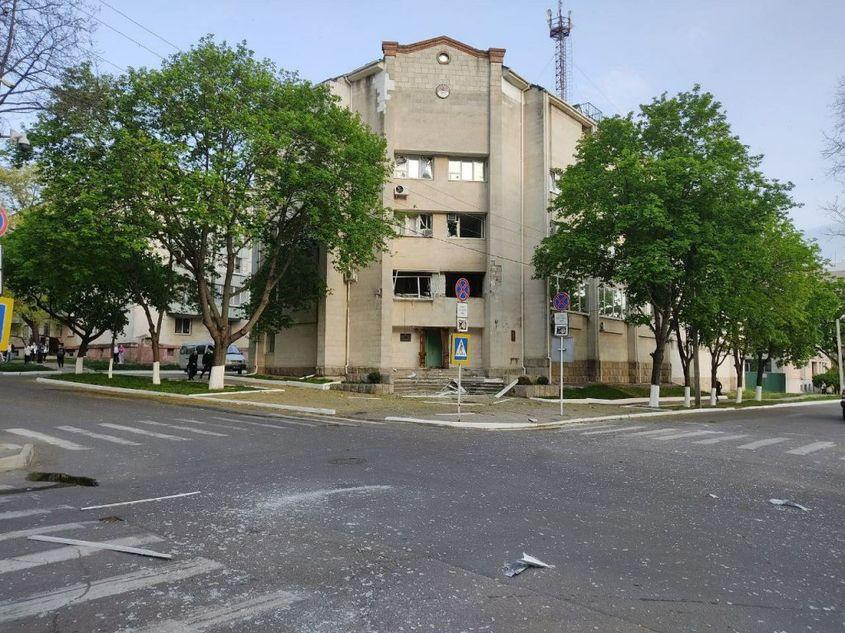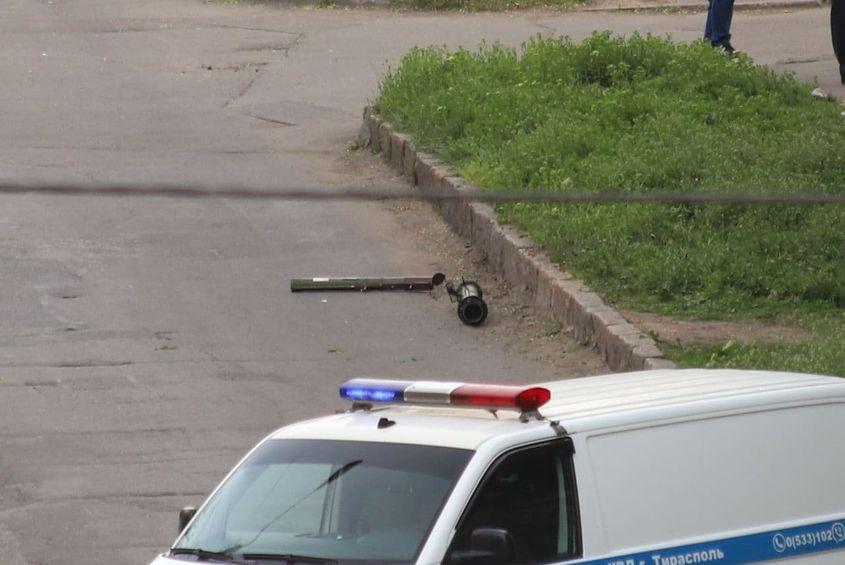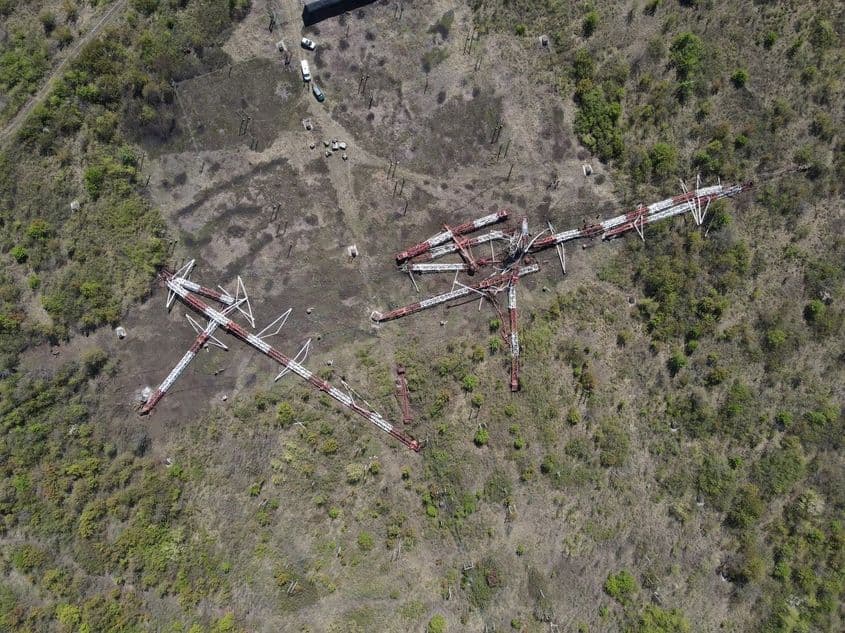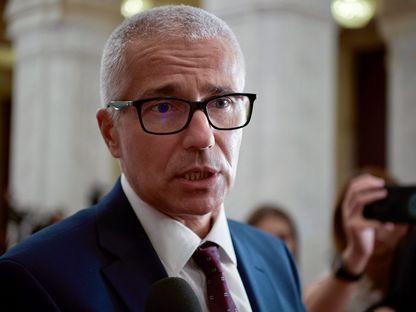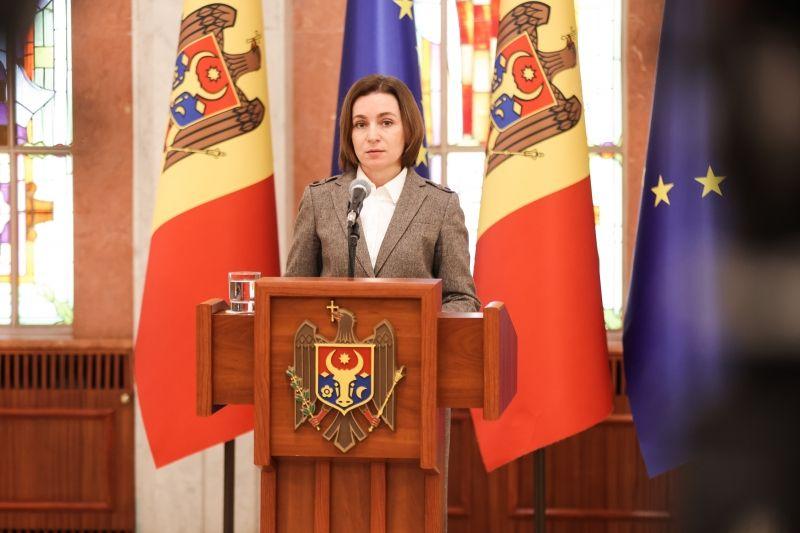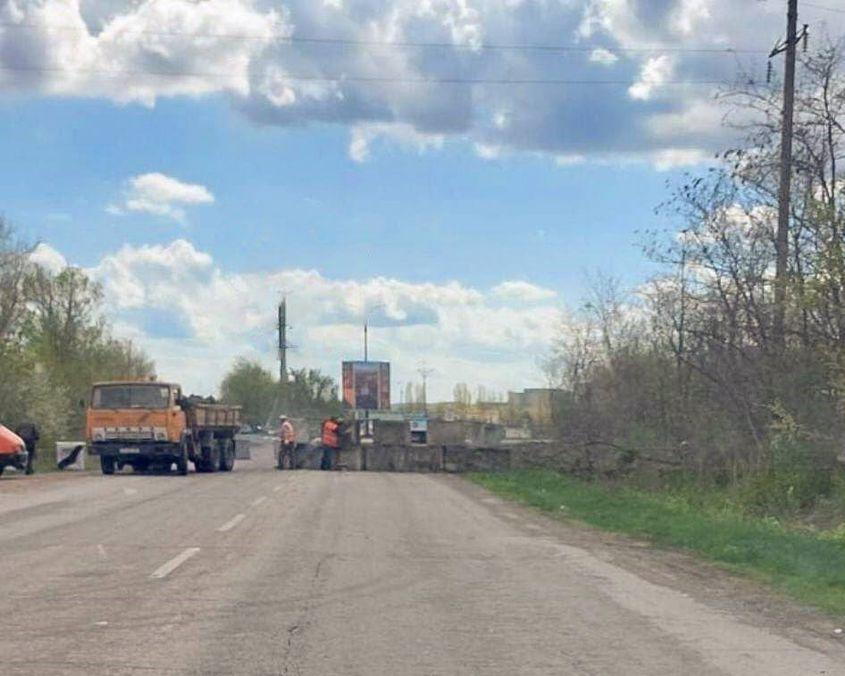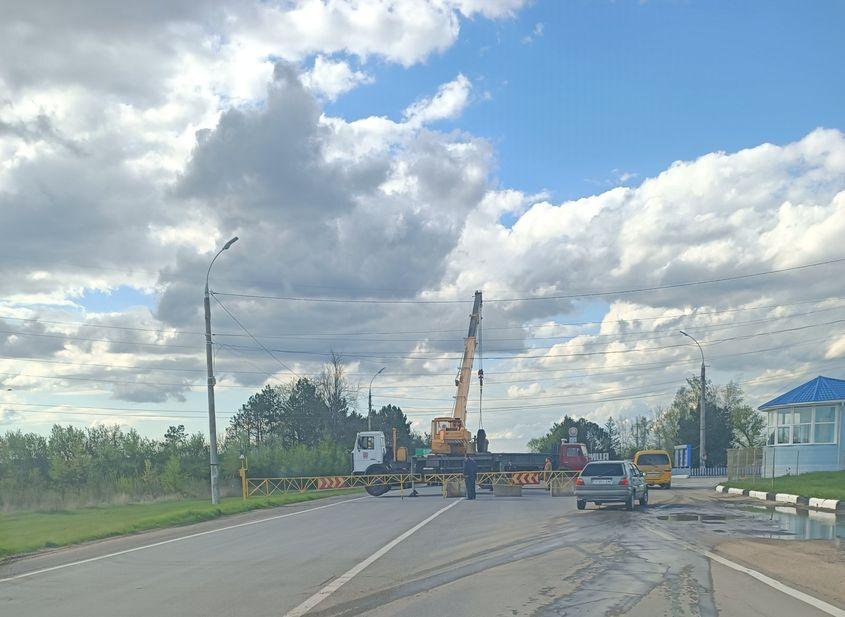Photo of the first pro-Russian protest in Tiraspol, March 2022. Source: PressOne

Photo of the first pro-Russian protest in Tiraspol, March 2022. Source: PressOne
29/04/2022
Moldova: What is Transnistria Preparing For?
Regardless of the existence of a separatist region in Moldova, religious holidays are valid on both sides of the Dniester, so Monday, April 25, in both Tiraspol and Chisinau, it was the second day of Easter, a day you certainly don't choose to organize an attack on an empty building. But, alas, it happened.
The building of the alleged Ministry of Security, called MGB, in the breakaway region of Transnistria was allegedly attacked with grenade launchers. The regime's position is that there were at least three explosions. The attackers targeted the second floor of the building and the impact damaged windows, doors and nearby apartment blocks.
After the explosion, everything was done so that as many photos as possible - both of the damaged building and of the weapons used - appeared in the public space. In the first hour after the blast, the Kremlin press was broadcasting live footage from the scene on its highest-rated programmes.
Those who are familiar with the street where the Transnistrian MGB building is located know how secure it was, with other institutions of force nearby. And the lack of suspects detained to date, or images of the moment the grenades were thrown, raises even greater suspicions.
One of the launchers allegedly fired at the Transnistrian MGB building. Source: Telegram zonadesecuritate.md
The initial reaction was that it was a set-up. Many of those living in the region told us this, in private discussions with us, and the same impressions are shared by analysts in Chisinau. A sham. A cheap provocation. That's how some have labeled it, especially since the launchers used are said to be part of the regime's equipment: RPG-27 (РПГ-27 "Таволга").
On the morning after the first explosions, information emerged about another alleged attack on the "Maiak" radio transmitter park in the village with the same name, in Grigoriopol district.
Maiak
Mulți ne citesc, puțini ne susțin. Fără ajutorul tău, nu putem continua să scriem astfel de articole. Cu doar 5 euro pe lună ne poți ajuta mai mult decât crezi și poți face diferența chiar acum!
Maiak is one of the biggest transmitters on the territory of the Republic of Moldova, inherited from the USSR. It is a strategic target owned by the Russian Federation.
In 2007 it was bought by "Rossiiskaya Televizionaia i Radioveschatelinaya Seti" (ФГУП "Российская телевизионная и радиовещательная сеть") - an enterprise owned by the Government of the Russian Federation, which has a monopoly on TV and radio signal retransmission.
Several years ago, due to weather conditions, part of the station complex was knocked to the ground by frost or ice (the antennas fell under the weight of the ice).
The most important component of the station remained functional. The transmitter complex consisted of several mobile antennas that moved along train tracks, so that they could be repositioned if necessary. From the pictures after the explosion we can see that not all of them were knocked out.
It was assumed that the station was guarded by the Russian military in the Transnistrian region (this was to be confirmed this summer) and had jamming capabilities for military radio communication systems.
THE JUSTICE MINISTER’S PLAGIARIZED DOCTORATE. 140 pages of copied content in Radu Marinescu’s thesis
More than half of Justice Minister Radu Marinescu’s PhD thesis in Law is plagiarized. According to PressOne’s analysis, at least 56.68% of the pages of the work titled The System of Means of Evidence in Civil Proceedings contain text copied from other authors — specifically 140 pages out of the thesis’s 247 pages.
The station is only a few kilometers away from Ukraine.
Video: Archive footage of the transmitter
Un newsletter pentru cititori curioși și inteligenți.
Sunt curios
Reportedly, there were also explosions at two other targets in the region: the Tiraspol airfield and one of the paramilitary units near the city.
A Ping-Pong of Scenarios
Yesterday afternoon, April 26, the Supreme Security Council (SSC) was convened by Moldovan President Maia Sandu, who adopted four decisions to secure the right bank of the Dniester, given that they cannot control the left bank.
1️. Increased control of internal customs posts adjacent to the Transnistrian region;
2️. Increased internal and border checks;
3️. Increasing the level of alert related to securing critical infrastructure objectives;
4️. Increasing the alert level of all institutions responsible for ensuring public order and security.
Maia Sandu's briefing was probably one of the most anticipated briefings since the Russian Federation's invasion of Ukraine. We were all waiting to see how she would categorize the actions in the region and who would be the perpetrator.
Sandu confirmed the assumptions of several analysts: the origin of the explosions is not external.
„What has been happening over the last 24 hours in the Transnistrian region is an escalation of tensions. (...) Our analysis so far shows that there are tensions between different forces within the region interested in destabilising the situation. This makes the Transnistrian region vulnerable and creates risks for the Republic of Moldova. (...) The Republic of Moldova does not intend and does not carry out a blockade of the Transnistrian region. We remain open to continue the dialogue for the settlement of the conflict in the region in a peaceful, diplomatically negotiated manner”, Sandu said in her speech.
Moreover, Sandu sent a message of support to Moldovan citizens who are settled on the left bank of the Dniester. "These tensions are taking place on territory which, de facto, is not controlled by Chisinau authorities. But this is the territory of the Republic of Moldova, and our citizens live there. Peace, protection of life and well-being of citizens is our priority."
Tiraspol's version is different from Chisinau's. That surprised no one.
The alleged president of Transnistria, Vadim Krasnoselski, blames Ukraine for the attacks in the Transnistrian region and assures everyone that "Transnistria will be able to defend itself" if it gets involved in the war.
"As the first findings of urgent operational and investigative measures have shown, the traces of these attacks lead to Ukraine... I assume that those who organized this attack have the aim to draw Transnistria into the conflict. And I can say with confidence that it will not work. Transnistria will be able to defend itself," the separatist leader said.
He also addressed a message to the country's constitutional leadership: "Do not give in to provocations, do not let Moldova be drawn into aggression against Transnistria. We still have to remember our peaceful ways."
The fact is that Moldova has never admitted to attacking the Transnistrian region, and Krasnoselski's insinuations leave room for interpretation.
At the same time, the Tiraspol leader rejected the presidency's position that the attacks were organized from within.
Ukraine has blamed these actions on Russia and claims that the Russians would carry out false-flag attacks to open a second front for the war.
Code Red Terrorist Attack
Strange to hear from Krasnoselski, who on paper is Ukrainian, that the "traces" of these "attacks" come from the country whose passport he holds and which he has visited many times - for holidays and business. It is well known that both the official and unofficial leadership of the phantom republic is very closely linked to Ukraine, and such outbursts put them at risk, leaving them with only one source of import, export and exit - Chisinau.
But even as it burns its already shaky bridges with Ukraine, Tiraspol is also barricading itself from the right bank.
The events of the last few days have prompted the region's administration to impose a 15-day terrorist attack code red, which involves militarising the region, which was already a heavily armed one. Another effect of the destabilization is that the "famous" May 9 parade in Tiraspol has been canceled.
Armed men are everywhere on the streets, exits and entrances to the towns are monitored, and concrete blocks have appeared in some places.
All these restrictions will infringe on the free movement of the people, which was already limited. The Reintegration Policy Office, the structure in charge of the reintegration of the two banks of the Dniester, has expressed its concern in this regard.
"Among the measures taken, we note an exaggerated and unjustified restriction of the unhindered movement of various categories of citizens, by strengthening the infrastructure of unauthorized checkpoints on the perimeter of the administrative line, stopping and thoroughly checking every means of transport entering/exiting the region, forcing people moving in the region to be taken to the Tiraspol structures."
Such strict control has only been in place during the pandemic, when the region isolated itself. It was already hard, after that period, to remove the impediments to free movement. Now the reason is security, and removing them could be even more problematic.
However, if the 'footprints' come from Ukraine, why is the regime in Chisinau barricading itself in? This is a question I hope we will have the opportunity to ask the so-called authorities in the region some day.
What is certain is that society is expecting other situations similar to those that have already occurred, and fears are also fuelled by some statements made before the explosions, such as that there is a second phase of Russia's 'special operation' involving the creation of a corridor to the Transnistrian region.
An impossible exercise as long as Odessa holds out. Until then, Peskov, Putin's spokesman, commented only briefly on the explosions on the left bank of the Dniester.
"We are monitoring very closely how the situation there develops. The news of what has happened caused concern for us."
What is certain is that some 1,700 military personnel continue to be present on the left bank of the Dniester as part of the contingent of Russian forces illegally stationed in the region, and there is a Russian-led peacekeeping mission on both banks of the Dniester. A more complicated equation than that can only be found in Ukraine.
In Moldova, however, everything seems so unpredictable now that it feels like anything could happen.

Avem nevoie de ajutorul tău!
Mulți ne citesc, puțini ne susțin. Asta e realitatea. Dar jurnalismul independent și de serviciu public nu se face cu aer, nici cu încurajări, și mai ales nici cu bani de la partide, politicieni sau industriile care creează dependență. Se face, în primul rând, cu bani de la cititori, adică de cei care sunt informați corect, cu mari eforturi, de puținii jurnaliști corecți care au mai rămas în România.
De aceea, este vital pentru noi să fim susținuți de cititorii noștri.
Dacă ne susții cu o sumă mică pe lună sau prin redirecționarea a 3.5% din impozitul tău pe venit, noi vom putea să-ți oferim în continuare jurnalism independent, onest, care merge în profunzime, să ne continuăm lupta contra corupției, plagiatelor, dezinformării, poluării, să facem reportaje imersive despre România reală și să scriem despre oamenii care o transformă în bine. Să dăm zgomotul la o parte și să-ți arătăm ce merită cu adevărat știut din ce se întâmplă în jur.
Ne poți ajuta chiar acum. Orice sumă contează, dar faptul că devii și rămâi abonat PressOne face toată diferența. Poți folosi direct caseta de mai jos sau accesa pagina Susține pentru alte modalități în care ne poți sprijini.
Vrei să ne ajuți? Orice sumă contează.
Share this


